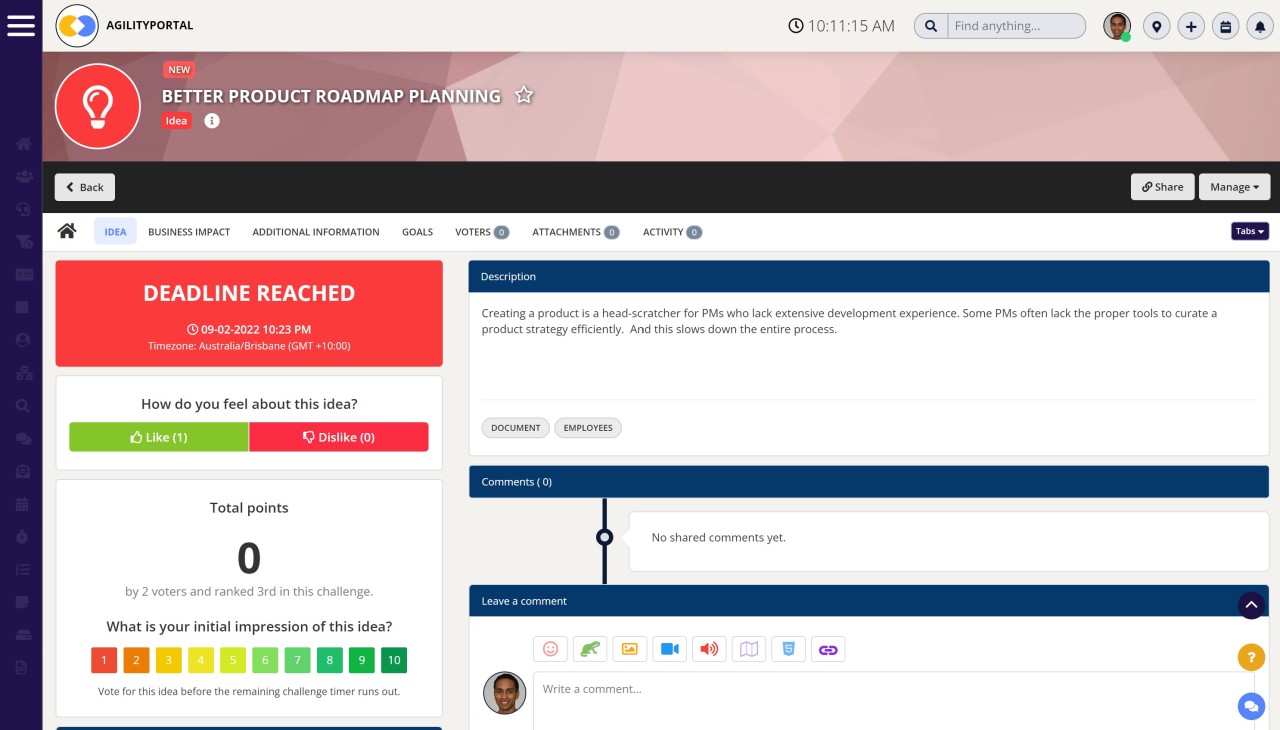Insight Blog
Agility’s perspectives on transforming the employee's experience throughout remote transformation using connected enterprise tools.
7 minutes reading time
(1432 words)
How can you use crowdsourcing to boost your company's innovation?
By using crowdsourcing, you are creating a flavor that already has positive feedback from your employees. The key to staying in business is providing employees a way to provide innovating ideas.
Businesses have traditionally relied on internal research and development to come up with innovative product and service concepts.
The power of a huge group of minds may be harnessed through crowdsourcing, which can help you get your innovation off the ground. Even so, the majority of organizations are still relying on market research to come up with new ideas and address challenges.
Let the market do the legwork for you, and your invention will soar.
We'll show you how crowdsourcing works in this article.
Crowdsourcing: What is it?
To put it another way, crowdsourcing is the process of enlisting the help of a large number of people in order to find a solution to a certain issue Employees, for example, are often the primary target of crowdsourcing projects, although this is not always the case.
Crowdsourcing, on the other hand, enlists the help of a much larger group of people to solve a specific problem. Employees, clients, admirers, or members of specialized groups can all fall under this category (for example, software coders).
Companies in any stage of development, from start-ups to scale-ups to global giants, can benefit from crowdsourcing.
Social media can be used to crowdsource as well, for example using hashtag in twitter and analyzing hashtag usage statistics. By leveraging the power of social media, businesses can collect a wealth of ideas and feedback from potential customers and employees. This can be an invaluable resource for brainstorming new products or making improvements to existing ones. In addition, crowdsourcing can help to build buzz and excitement around a company's products or services. Ultimately, by harnessing the power of social media, businesses can tap into a vast pool of talent and ideas.
- Define the problem or challenge you are trying to solve. This will help to focus the discussion and ensure that all ideas are relevant.
- Encourage everyone to participate. The more input you have, the better.
- Be open to all ideas, no matter how crazy they may seem at first. You never know where the next great idea will come from.
- Use voting or other methods to narrow down the list of options. This will help to prevent decision fatigue and ensure that only the best ideas are considered.
- Implement the solutions that are chosen. This is the only way to truly find out if they work!
How crowdsourcing can be beneficial for companies?
Using crowdsourcing, companies may speed up and improve the success rate of their innovation processes. This is for a variety of reasons.
- Use social media: Social media platforms like AgilityPortal are great places to crowdsource ideas. By using hashtags and tagging relevant people in your posts, you can quickly reach a wide audience.
- Leverage online communities: There are many online communities dedicated to topics like innovation and creativity. These communities can be great sources of new ideas and perspectives.
- Hold virtual brainstorming sessions: Brainstorming is a powerful tool for generating new ideas. When you can't meet in person, hold virtual brainstorming sessions using video conferencing tools like Skype or Google Hangouts.
- Use online surveys: Online survey tools are an easy way to gather feedback from a large group of people. You can use survey tools like SurveyMonkey or Google Forms to create your survey and collect responses.
- Run a contest: Contests are a great way to engage people and get them thinking about your problem or challenge. Use social media, email, or even physical mailers to promote your contest and encourage people to submit their best ideas.
Generates crowd buzz and make marketing easier
An entertaining spectacle for employees, fans and consumers, crowdsourcing is also a terrific way to gain access to new ideas.
Crowdsourcing piques the interest of a broader demographic due to its emphasis on competition. People who might have a brilliant idea but aren't heard because of their lack of professional competence or experience find it appealing that everyone can submit a solution.
One of the better instances of this kind of marketing buzz at work is the Lego Ideas website. Every time Lego releases a new crowdsourced product, a long line of customers is already waiting in the cold to purchase the item.
Crowdsourcing saves a lot of money because the target audience already exists in the form of company employees, supporters, and customers.
Use your existing resources for innovation
According to a 2011 report by PWC, CEOs believe that innovation is the best path to growth. According to the CEOs polled, 79% believed that their innovations would improve efficiency and provide them a competitive edge, while 78% said that innovation would open up new revenue streams.
Although this is the case, businesses often struggle to make the best use of the ideas, skills, and energy of the individuals who work for them.
Using internal crowdsourcing as a means of creating solutions can be highly productive since it allows firms to cast a wide net and get input from a wide variety of people. It is possible to gain a new perspective on a problem by looking at it from a different angle.
The PWC report referred to above also explains how crowdsourcing improves employee engagement by giving individuals a voice and making them feel like they have an active role in driving the business ahead.
Easily generate ideas and test them out to see if they're viable
Companies can use crowdsourcing to see if new products or ideas have a wide appeal before investing time and resources into developing them. This not only saves money, but it also assures that the product has a wider audience before it goes on sale.
The Starbucks 'My Concept' platform is a great illustration of this idea validation in action. In this section, Starbucks encourages customers and admirers alike to share their ideas for new products and system and process improvements.
Customers can cast their votes for their favorite concepts on the site, and a leaderboard displays the most popular concepts each month. For Starbucks, this platform has been a big success, leading to fan favorite cake pops and Frappuccino happy hour.
Helps to increase engagement and retention
The difficulty of retaining great employees is exacerbated by the high rate of job switching among millennials. In the United States, the number of companies people worked for in the first five years following college has nearly doubled over the past two decades.
Businesses put a lot of time and money into hiring the greatest people, but they may not have a system in place that allows this talent to thrive. When it comes to priorities, millennials value advancement and development above cash compensation.
Having worked in a large corporation as a recent graduate, I understand the trepidation and anxiety that comes with questioning the status quo.
"Speak up if anything we're doing doesn't make sense to you" is a common piece of advice, but it's a lot easier said than done. Is there any way to voice your concerns and oppose the way things are done if there is no outlet for doing so?
Get unlimited unexpected ideas
Companies and organizations can have access to previously unheard of ideas through the use of crowdsourcing. In many cases, these unexpected thoughts can lead to new and improved methods of doing things.
Crowdsourcing relies on many different people giving their thoughts, which is why that is the case. Because of this distributed thinking, firms can no longer rely just on one person. Instead, they might look beyond what is expected of them and discover new perspectives.
Boost knowledge sharing
An efficient forum for exchanging tales helps prevent crucial information from sliding through the cracks. Dispersed teams can benefit from technologies like social intranet, which allow employees to express themselves, engage with one another, and provide input on company-wide initiatives.
Collaboration and idea sharing are boosted by these solutions. They also aid in the transition away from the traditional one-way, top-down communication approach to a more inclusive setup that includes bottom-up dialogue.
As a result, employees feel a sense of belonging and are more likely to contribute to the greater good.
Categories
Blog
(2600)
Business Management
(319)
Employee Engagement
(207)
Digital Transformation
(173)
Intranets
(119)
Growth
(118)
Remote Work
(61)
Sales
(48)
Collaboration
(37)
Culture
(29)
Project management
(29)
Customer Experience
(26)
Knowledge Management
(21)
Leadership
(20)
Comparisons
(5)
Ready to learn more? 👍
One platform to optimize, manage and track all of your teams. Your new digital workplace is a click away. 🚀
Free for 14 days, no credit card required.














